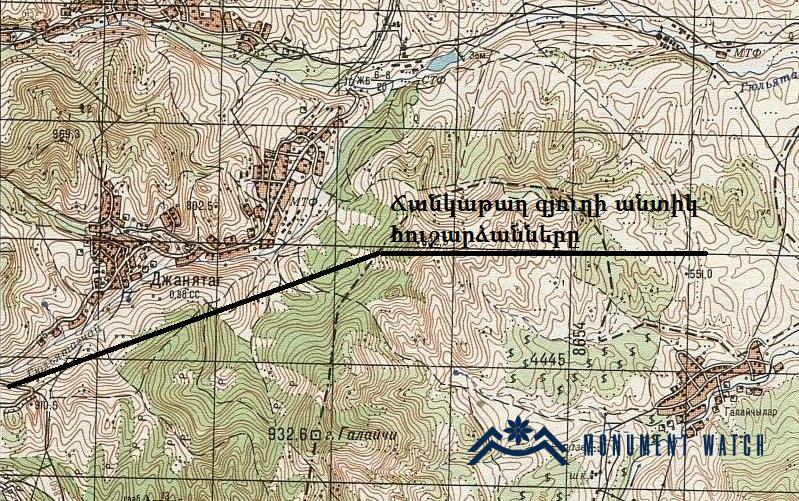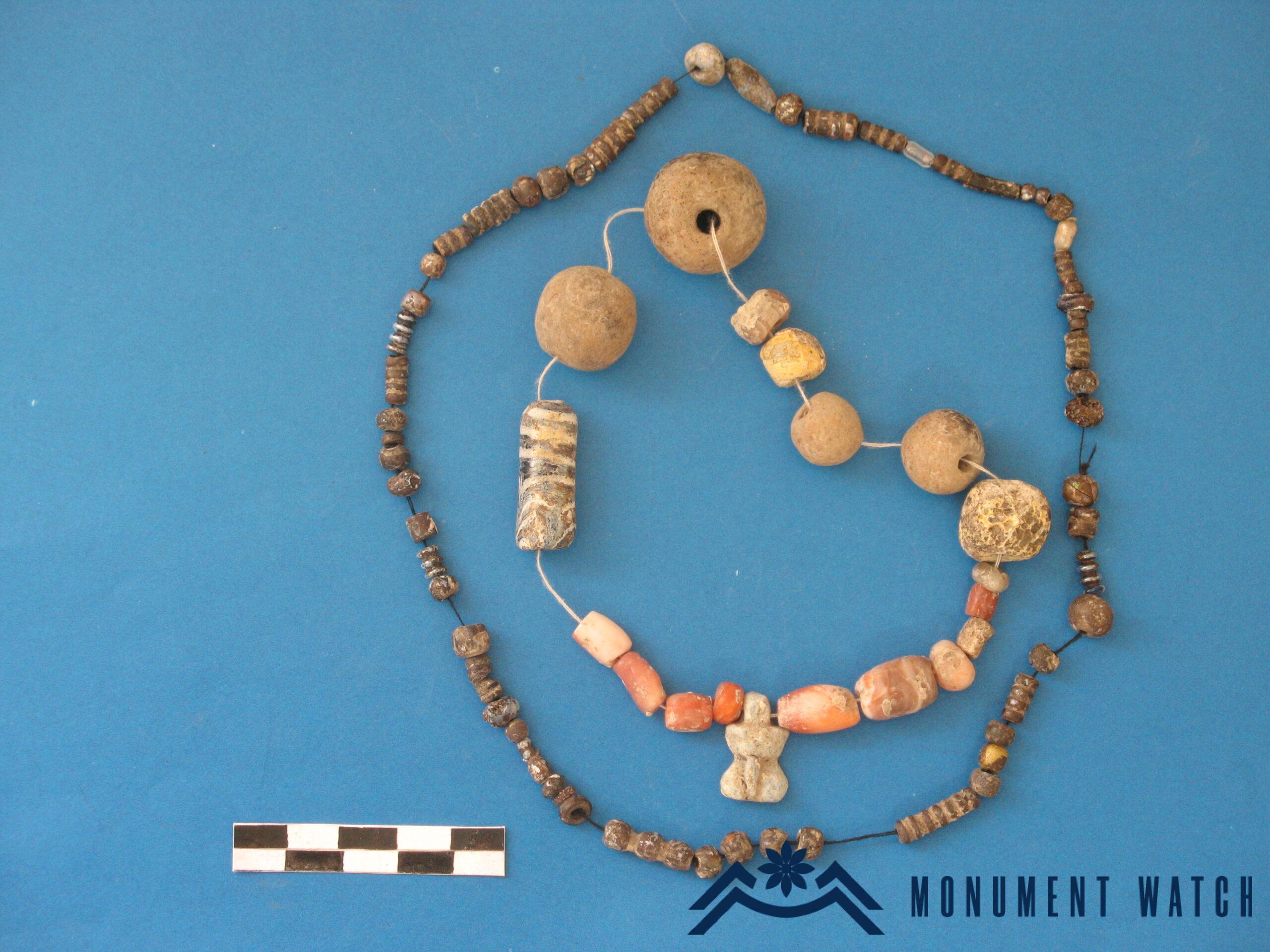Ancient monuments of Chankatagh village. Jar burials
Location
The monument is situated approximately 2 kilometers southwest of Chankatagh village, within the Martakert region of the Artsakh Republic. It is located in an area known as "Meghraker." However, it is important to note that this region has been under Azerbaijani occupation since September 2023.
Historical overview
Chankatagh is one of the oldest settlements in Artsakh, as evidenced by the tombstones from the 2nd to 1st millennia BC preserved in the village, along with traces of ancient settlements and cemeteries. Fifty-one monuments in Chankatagh are listed by the Department of Tourism and Historical Environment Protection under the Artsakh government. Notable sites include the 1st-century burial ground, the ruins of the "Tsovathegh" village, and the church and khachkars (cross-stones) dating from the 9th to 14th centuries.
Makar Bishop Barkhudaryants, noting the antiquities of the settlement, wrote that "in the place called 'Meghraker' there is a resting place, a village, and the ruins of a church" (Barkhudaryants 1895, 214). He was likely referring to the ruins of the medieval village and grave that are still visible at the "Meghraker" site today (Fig. 1).
Archeological examination
Among the diverse ancient burial structures in Artsakh and Utik, such as slab boxes, stone boxes, egg-shaped cells, and earthen cells, jar burials became prevalent at the end of the 1st century BC and AD. In 1998, jar burials were accidentally discovered in the "Meghraker" area, located 2 km southwest of the village of Chankatagh in the Martakert region (Petrosyan 2021, 293).
The site examination revealed a cemetery with pottery burials spanning approximately one hectare (Fig. 2). The burial jars are aligned from east to west, with the tops of the jars facing east. The deceased were placed inside the jars in a crouching position, with their heads oriented towards the east.
One of the destroyed burial jars features a wide neck (outer diameter: 0.5 meters, inner diameter: 0.38 meters), an obliquely cut rim, an elongated body, and a flat, narrow bottom (0.15 meters in diameter). The jar stands 1.65 meters tall, with a maximum diameter of 1.00 meters and wall thickness ranging from 0.20 to 0.25 meters. The wide, flared rim is adorned with an incised pattern at the bottom (Fig. 3). A prominent decorative belt encircles the widest part of the jar. Similar jars have been found at Garni, Oshakan, and other ancient sites (Tiratsyan 1985, 67). The jar was sealed with a small slab.
Three fragments of a round silver mirror, a cylindrical glass bead, a biconical stone bead, a bronze ring, a segmented bronze earring with non-joining ends, and a bronze chain consisting of six rings were found in the tomb (Fig. 4).
During the re-examination of the second tomb, not far from the burial jar, two single-handled jars of the "oinochoe" type, common in the Hellenistic period, were discovered (Fig. 5). Examples of colored pottery of this type are known from Armavir, Artashat, Garni, Dvin, Hatsavan, Shirakavan, Karjaghbyur, Geghadir, Oshakan, Lusakert, and other locations, dating back to the 2nd-1st centuries BC.
Due to the importance of studying jar burials, exploratory excavations were conducted in the fall of 2006 at this cemetery.
Excavations took place 2 meters south of the destroyed jars. In the northeastern corner of the excavated square, at a depth of 0.58 meters, various beads were discovered: carnelian, copper, silver-plated glass, and paste (79 pieces in total), along with a fragment of an iron ring. Notably, there were also clay beads, an agate bead, and a spacer connecting the bead string (Fig. 6).
In the excavated square, a large burial jar was discovered at a depth of 0.8 meters, placed horizontally, and oriented west to east. The urn measures 1.65 meters in height, with a lip diameter of 0.50 meters and a bottom diameter of 0.15 meters. Its torso is ovoid, featuring two reliefs of a rope-braided horizontal ornament at its widest part. The top of the urn ends with a flat lip that extends outward, decorated with a wavy belt along its edge. Next to the burial jar, at the same depth, traces of ash and burnt walnuts were found. The lip of the urn was sealed by the bottom of a smaller, double-edged crucible (Fig. 7). Additionally, a single-handled jar was discovered resting on the neck of the jar (Fig. 8).
The deceased was placed in the urn in a tightly crouched position, lying on his right side with his head facing east. Inside the urn, an assortment of iron artifacts was found: a single-edged knife, part of a small scissor for cultivating grapes, four ring-shaped buckles, two round objects (buttons), a nail, and a needle.
A small exploratory trench (2x1 meters) was excavated 3 meters north of the discovered jar. At a depth of 0.3 meters, a human skeleton was found covered with two large fragments of a jar. The skeleton was in a crouched position on its right side, with the head facing east and hands near the face (Fig. 9). At the same depth, 0.8 meters east of this skeleton, sheep bones were discovered.
Approximately 60-70 meters northeast of the excavated square, residents discovered jars and bowls from the Hellenistic period during earthworks. Subsequent exploratory work in this area revealed pottery fragments at a depth of 0.45-0.55 meters on a hill, 3 meters east of the present road. Nearby, 12 glass beads and two bronze bell pendants were also found. Below this layer, the mother earth was exposed. It appears that during mining activities, most of the cultural layer was destroyed (Safaryan, Chankatagh village of NKR Martakert region, 2011; Safaryan 2011; Safaryan 2012).
Among the notable features of the burials discussed are the creation of plaster platforms adjacent to the burial urns and their consecration with fire. Additionally, there is a custom of placing vessels near the neck of the jar containing the deceased.
The condition before, during, and after the war
Before the war, the monument was in good condition. There is no information available regarding the current state of the monument.
Bibliography
- Barkhutareants 1895 - Makar Bishop Barkhutareants, Artsakh, printing house "Aror", Baku.
- Khachatryan 1981 - Khachatryan J., Artashat 2, Ancient burial grounds (1971-1977 excavations), Yerevan.
- Safaryan, of Chankatagh village, Martakert region of NKR 2011 - Safaryan V., The main results of the excavations in the area of Chankatagh village of Martakert region of NKR / Archaeological studies in Artsakh in 2005-2010. / Department of Tourism under the NKR Government, Stepanakert, pp. 134-142.
- Safaryan 2011 - Safaryan V., The first attempt to study jar burials on the territory of Artsakh, Armenological Journal, No. 2, Stepanakert, 2011, pp. 170-186.
- Petrosyan 2021 - Petrosyan H., Safaryan V., Karapetyan I., Kirakosyan L., Vardanyan R., Vardanesova T., Gabrielyan A., Pithos Burials of Tirganakert of Artsakh, Archaeology of Armenian regional context II, International Conference dedicated to the 60th Anniversary of the Institute of Archaeology and Ethnography, Yerevan, 2021, pp. 293–304.
- Tiratsyan 1985 - Archeology of the USSR (under the general editorship of B. Rybakov), The most ancient states of the Caucasus and Central Asia, part 1, chapter 5, South Transcaucasia, Tiratsyan G. Armenia in the III-I centuries BC, Publishing house " Science", Moscow, p. 67.
- Safarian 2012 - Safarian V., Ceramics of jar burials of Artsakh during the Hellenistic period, Proceedings of the international scientific and practical conference “All-Russian and national identity”, April 19-20, 2012, Pyatigorsk, pp. 487-498.
Ancient monuments of Chankatagh village. Jar burials
Artsakh









